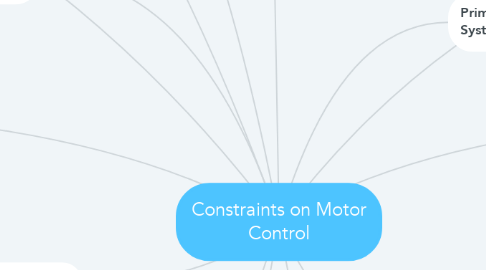
1. inability to scale forces, problems judging distance and range
2. ability to focus on a specific stimulus without being distracted, critical for motor learning
3. Incoordination
3.1. awkward, uneven, innacurate movements
4. Loss of reciprocal inhibition
5. Altered diminished gaze stabilization, altered posture/postural control, vertigo and dizziness
6. Primary Cognitive System Impairments
6.1. Arousal and level of Consciousness
6.1.1. must respond to stimuli in environment
6.2. Attention
6.3. Orientation
6.3.1. Decreased understanding of person, place, time, situational awareness
6.4. Memory
6.4.1. Ability to process, store, and retrieve information
6.5. Cognitive process hierarchy
6.5.1. Arousal > Focused attention > sustained attention > selective attention > alternating attention > divided attention
6.6. Problem Solving
6.6.1. Applying knowledge to new situations
7. Motor Impairments
7.1. Muscle weakness
7.2. Coordination problems
7.3. involuntary movements
7.4. abnormalities of musle tone
7.5. Abnormal synergies
8. Muscle Tone Changes
8.1. Spasticity
8.1.1. Velocity dependent muscle tone, reticulospinal tract
8.1.2. 3 stages: Flaccid, emergent spasticity, recovery from spasticity
8.1.3. Brunnstrom Scale
8.1.4. Tests: Pendulum, clonus, ashworth scale,
8.2. Tone
8.2.1. Tardieu Scale
8.2.2. Hypertonicity, hypotonia, flaccidity
8.2.3. Abnormal synergies
8.2.3.1. mass movement & inability to isolate or fractionate joint motions from one another
8.2.3.2. Upper extremity vs Lower Extremity vs Flexion vs. Extension
9. Neuromuscular Impairments
9.1. Sequencing Problems
9.1.1. Activation of muscle groups in wrong order
9.2. Timing problems
9.2.1. Issues initiating movement
9.3. Slowed movementds time
9.3.1. CVA, PArkinsons, CP, Cerebellar
9.4. Problems terminating a movement
9.4.1. Cerebellar lesion
9.5. Dysmetria
9.5.1. Hypometria (BG lesion)
9.5.2. Hypermetria (Cerebellar lesion)
9.6. Dysarthria
9.6.1. motor disorder of speech production
9.7. Dysdiadochokinesia
9.7.1. Rapid alternating movement patterns
9.8. Involuntary Movements
9.8.1. Dystonia, associated movements, tremor, choreiform movements, athetoid movements
10. Phoria
10.1. deviation only sometime present
11. Loss of discrimination, touch, light touch, kinesthesia, loss of pain, temperature, coarse touch, proprioception, stereognosis
12. Primary Sensory System Impairments
12.1. DCML, Anterolateral lesions
12.2. Vestibular Defecits
12.2.1. Nystagmus
12.2.1.1. Peripheral vs. Central
12.3. Visual Defecits
12.3.1. Depth perception, visual fields, acuity, oculomotor control
12.3.2. Tropia:
12.3.2.1. deviation that is always present, cant always see without testing
13. Primary Perceptual Impairments
13.1. Visual Vertical
13.1.1. inability to align vertically
13.1.1.1. unequally dominating on one side, but patient things they’re standing upright
13.2. Postural Vertical
13.3. Body Scheme Disorders
13.3.1. decreased awareness of body parts relationship to each other
13.4. Unilateral Neglect
13.4.1. inability to perceive and integrate stimuli on one side of the body
13.5. Apraxia
13.5.1. Typically left sided brain damage, inability to carry out purposeful movement. Poor motor planning and problem solving
13.6. Spatial relation disorders
13.6.1. difficulty perceiving relationships between self and objects, ex: position in space, figure ground discrimination
